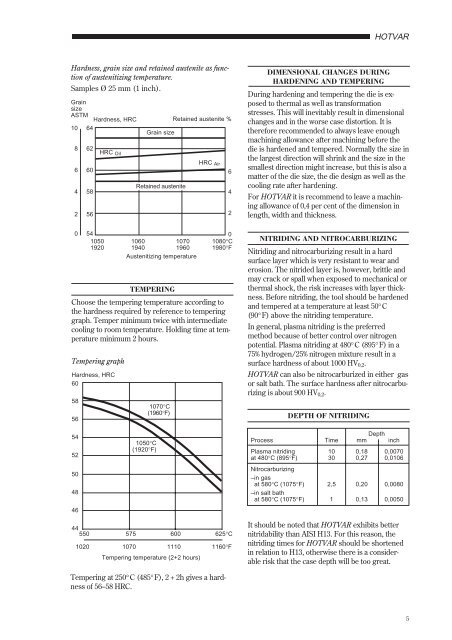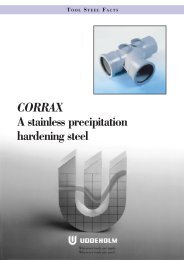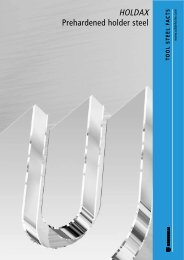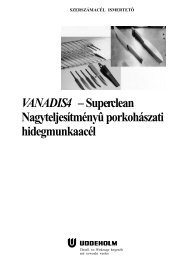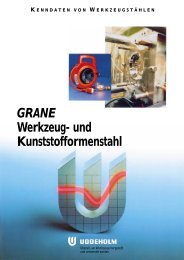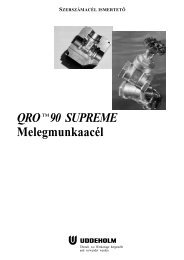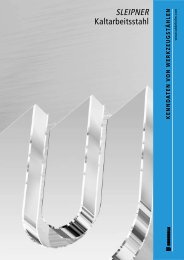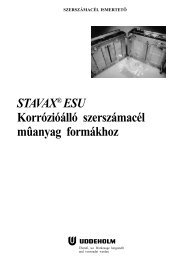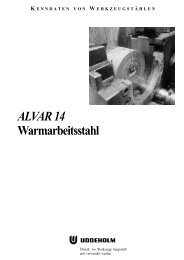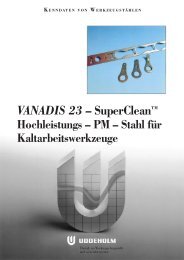HOTVAR⢠Hot work tool steel - Uddeholm
HOTVAR⢠Hot work tool steel - Uddeholm
HOTVAR⢠Hot work tool steel - Uddeholm
You also want an ePaper? Increase the reach of your titles
YUMPU automatically turns print PDFs into web optimized ePapers that Google loves.
HOTVAR<br />
Hardness, grain size and retained austenite as function<br />
of austenitizing temperature.<br />
Samples Ø 25 mm (1 inch).<br />
Grain<br />
size<br />
ASTM<br />
Hardness, HRC<br />
10 64<br />
8<br />
6<br />
4<br />
2<br />
0<br />
TEMPERING<br />
Choose the tempering temperature according to<br />
the hardness required by reference to tempering<br />
graph. Temper minimum twice with intermediate<br />
cooling to room temperature. Holding time at temperature<br />
minimum 2 hours.<br />
Tempering graph<br />
Hardness, HRC<br />
60<br />
58<br />
56<br />
62<br />
60<br />
58<br />
56<br />
HRC Oil<br />
Grain size<br />
Retained austenite<br />
54<br />
0<br />
1050 1060 1070 1080°C<br />
1920 1940 1960 1980°F<br />
Austenitizing temperature<br />
1070°C<br />
(1960°F)<br />
Retained austenite %<br />
HRC Air<br />
6<br />
4<br />
2<br />
DIMENSIONAL CHANGES DURING<br />
HARDENING AND TEMPERING<br />
During hardening and tempering the die is exposed<br />
to thermal as well as transformation<br />
stresses. This will inevitably result in dimensional<br />
changes and in the worse case distortion. It is<br />
therefore recommended to always leave enough<br />
machining allowance after machining before the<br />
die is hardened and tempered. Normally the size in<br />
the largest direction will shrink and the size in the<br />
smallest direction might increase, but this is also a<br />
matter of the die size, the die design as well as the<br />
cooling rate after hardening.<br />
For HOTVAR it is recommend to leave a machining<br />
allowance of 0,4 per cent of the dimension in<br />
length, width and thickness.<br />
NITRIDING AND NITROCARBURIZING<br />
Nitriding and nitrocarburizing result in a hard<br />
surface layer which is very resistant to wear and<br />
erosion. The nitrided layer is, however, brittle and<br />
may crack or spall when exposed to mechanical or<br />
thermal shock, the risk increases with layer thickness.<br />
Before nitriding, the <strong>tool</strong> should be hardened<br />
and tempered at a temperature at least 50°C<br />
(90°F) above the nitriding temperature.<br />
In general, plasma nitriding is the preferred<br />
method because of better control over nitrogen<br />
potential. Plasma nitriding at 480°C (895°F) in a<br />
75% hydrogen/25% nitrogen mixture result in a<br />
surface hardness of about 1000 HV 0,2 .<br />
HOTVAR can also be nitrocarburized in either gas<br />
or salt bath. The surface hardness after nitrocarburizing<br />
is about 900 HV 0,2 .<br />
DEPTH OF NITRIDING<br />
54<br />
52<br />
50<br />
48<br />
46<br />
1050°C<br />
(1920°F)<br />
Depth<br />
Process Time mm inch<br />
Plasma nitriding 10 0,18 0,0070<br />
at 480°C (895°F) 30 0,27 0,0106<br />
Nitrocarburizing<br />
–in gas<br />
at 580°C (1075°F) 2,5 0,20 0,0080<br />
–in salt bath<br />
at 580°C (1075°F) 1 0,13 0,0050<br />
44<br />
550 575 600 625°C<br />
1020 1070 1110 1160°F<br />
Tempering temperature (2+2 hours)<br />
It should be noted that HOTVAR exhibits better<br />
nitridability than AISI H13. For this reason, the<br />
nitriding times for HOTVAR should be shortened<br />
in relation to H13, otherwise there is a considerable<br />
risk that the case depth will be too great.<br />
Tempering at 250°C (485°F), 2 + 2h gives a hardness<br />
of 56–58 HRC.<br />
5


